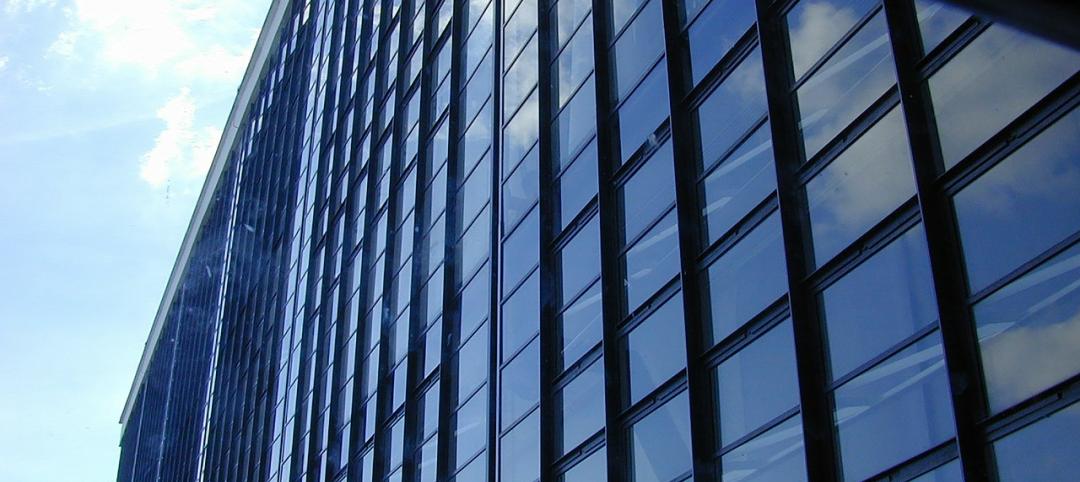Next month, nine remodeled gates inside Terminal 1 at San Francisco International Airport will reopen, with another nine scheduled to reopen in March 2020. The $2.4 billion remodel of this terminal should be completed in 2023.
This 1.2-million-sf net-zero-energy space, designed by Gensler, will include 57,000 sf of dynamic glazing supplied by View, a 12-year-old company based in Milpitas, Calif., that currently has its product in six of the top 15 airports in the U.S.
For example, the Terminal A expansion at Charlotte (N.C.) Douglas Airport included 20,000 sf of dynamic glass, with gate walls that are 40-ft-tall by 50-ft-wide glass walls. “We can do large-format glass that’s critically important to airports,” says Brandon Tinianov, View’s Vice President of Industry Strategy.
Unlike thermochromic glass that responds directly to changes in sunlight and temperature, View’s glass uses nano-layers of electrochromic coating on its surface. When voltage is applied, the glass tints. View’s intelligent system allows the windows to respond to the surrounding environment automatically, to eliminate heat and glare. Tinting of windows in rooms can be controlled by zones.
Tinianov concedes that the upfront cost for View’s glass is a barrier to entry for some clients. That’s why View emphasizes longer-term operating cost benefits, which can be substantial when HVAC systems can be downsized. View claims that its dynamic glass reduces a building’s energy consumption and costs by 18% annually, and can block more than 90% of solar radiation, thereby reducing peak cooling loads by 23%.
Tinianov also points to DFW International Airport in Texas, where View participated in a pilot study to gauge the relationship between passenger experience and revenue. A restaurant near two gates that was underperforming saw its revenue increase, on a year-to-year basis, by 102% after View installed dynamic glass on its eastern façade, says Tinianov.

The waiting area at a gate at DFW International Airport in Texas, with and without tinted glass. Image: Courtesy of View
Since the company’s inception, View has installed its glass in 50 million sf of buildings. Airports represent about 20% of View’s project portfolio. Healthcare and multifamily account for 10% each. And offices represent 60%. “The big value is office towers with thousands of windows,” says Tinianov. This month, the city of San Francisco and the developer Related topped off 49 South Van Ness, a 430,000-sf office building designed by Skidmore, Owings & Merrill that features View’s smart glass.
“We believe that a core role of architecture is improving human performance and enriching the human experience while using as few resources–particularly energy–as possible. The dynamic glass in this building plays a huge part in achieving those goals.” says Mark Schwettmann, SOM’s Design Director.
During the design phase of San Francisco’s Terminal 1 remodel, the building team evaluated six different sustainability measures, and, according to Tinianov, the scenario that included dynamic glass performed the best.
View sees growth potential in promoting dynamic glass for sustainability, health/wellness, and security. Every View installation now includes a smart building platform that consists of power, network, and communication infrastructure. This will allow View to add apps that can help manage a building’s physical and digital security, air quality, and acoustic levels.
Last November View partnered with Microsoft to launch SmartProtect, a window-based security solution that automatically detects glass breakage. The app leverages Microsoft Azure IoT service, Azure Digital Twin.
Related Stories
Accelerate Live! | Jun 24, 2018
Watch all 19 Accelerate Live! talks on demand
BD+C’s second annual Accelerate Live! AEC innovation conference (May 10, 2018, Chicago) featured talks on AI for construction scheduling, regenerative design, the micro-buildings movement, post-occupancy evaluation, predictive visual data analytics, digital fabrication, and more. Take in all 19 talks on demand.
Sponsored | | May 29, 2018
Accelerate Live! sponsor talk: Debunking daylight myths
In this 10-minute talk at BD+C’s Accelerate Live! conference (May 10, 2018, Chicago), SageGlass CEO Alan McLenaghan, PhD, debunks four common myths related to daylighting in commercial and institutional buildings.
Sponsored | | May 24, 2018
Accelerate Live! sponsor talk: The impact of new fire rated glazing technologies to design, performance, and the environment
In this 10-minute sponsor talk at BD+C’s Accelerate Live! conference (May 10, 2018, Chicago), Tim Nass, VP of Sales with SAFTI FIRST Fire Rated Glazing Solutions, details emerging applications for fire rated glazing technology.
Sponsored | Glass Technology | Jun 21, 2017
Are you allowing data thieves to listen to, monitor and steal your communications?
| Jun 13, 2017
Accelerate Live! talk: Work in progress—How the office environment drives innovation, SageGlass (sponsored)
SageGlass CEO Dr. Alan McLenaghan reviews how biophilic design and new technologies, such as dynamic glass, create a greater connection between the built and natural environments in the office.
Curtain Wall | Nov 4, 2015
Curved glass curtains will give Washington, D.C., office building more views and floor space
Around 900 fluted glass panes will cover 2050 M Street, which will contain television studios for CBS.
Glass Technology | Oct 27, 2015
Michigan State researchers develop fully transparent solar panels
The transparent luminescent solar concentrator device could be used on buildings or mobile devices.
BIM and Information Technology | Aug 28, 2015
MIT researchers develop 3D printer that produces intricate glass structures
The machine uses molten glass as its “ink,” contained in a “kiln cartridge” that heats up at 1,900 degrees until it is molten and pliable.
Sponsored | Glass and Glazing | Aug 17, 2015
Specialty tempered glass??
Tempered glass is an excellent choice for large expanses of glass that maximize clear views while providing significant wind load and thermal stress resistance.
Codes and Standards | Aug 6, 2015
AAMA updates methods for testing of exterior walls
The standard specifies test methods, specifications, and field checks to evaluate structural adequacy of exterior wall systems composed of curtain walls, storefronts, and sloped glazing.











